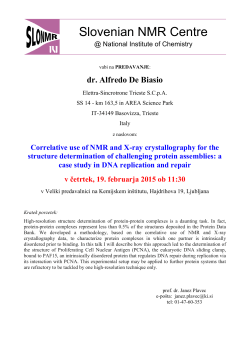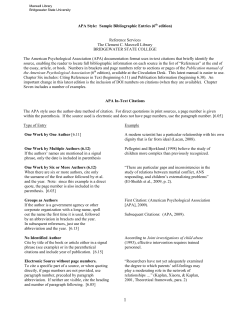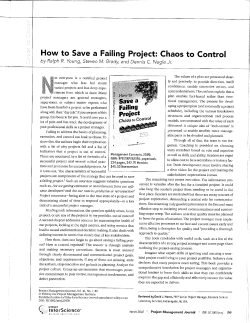
Organic Cumulative Exam February 13, 2014 LPSC 239 and LPSC 259
Organic Cumulative Exam February 13, 2014 LPSC 239 and LPSC 259 Answer only three of the six questions. No more than three question answers will be graded and any work not to be considered must be clearly marked as such. Clearly indicate which questions are to be graded on the front of your answer booklet. Good luck! ! 1. Question based on a previously distributed paper: J. Am. Chem. Soc. 2014, ASAP, DOI: dx.doi.org/10.1021/ja412290r. A. What is a Kemp elimination, and why is this reaction historically important to the field of organic catalysis? [5 points] B. Describe the key interaction responsible for the catalysis. What is the range of magnitude for this interaction? Is it stronger or weaker in the transition state? [5 points] C. Aside from the key interaction, what are three other structural/conformational factors that the authors probed? Briefly, what are their findings? [7 points] D. The authors have published a computed reaction coordinate diagram in the manuscript. Why might this reaction coordinate diagram be flawed and not reflect reality? What critical intermediate have the authors failed to include? In your estimation, would satisfactory treatment of this omission change the reaction coordinate diagram? How would it change? [9 points] E. In your opinion, does this work merit a publication in the Journal of the American Chemical Society? Why is this publication in JACS instead of Journal of Organic Chemistry or Tetrahedron? Substantiate your response with at least 2 points of argument that discuss the merits and weakness of this manuscript. For your reference, the four JACS review criteria are significance, novelty, broad interest, and scholarly presentation. [7 points] 2. The Robertson Group (U of Oxford) recently published a synthesis of pandamarilactone (Org. Lett. 2014, ASAP; dx.doi.org/10.1021/ol4036424). The synthesis is shown below. Starting material A was converted into an intermediate B. Intermediate B underwent an acidpromoted isomerization to padamarilactone. O 6 steps CN O A B achiral N H2SO4 O O O pandamarilactone 1. Show how to prepare A using simple commercial starting materials. 2. Give the structure of achiral intermediate B. 3. Show how starting material A can be converted into intermediate B (authors used 6 steps but you can use more if necessary). 4. The authors described the isomerization of B to pandamarilactone as a “biomimetic” step. Of course, not every synthesis is biomimetic. What aspects of this research could be used to argue that the step is “biomimetic”? You may suggest other experiments that could support the claim of biomimicry. 3. 33Pts. Baran and co-workers recently reported a new catalytic reductive coupling methodology. J. Am. Chem. Soc. 2014, DOI: 10.1021/ja4117632 A) 6 Pts. Boger et al. set the stage for this development with the shown reaction. Give the structures of 1 and 2. J. Am. Chem. Soc. 2009,131, 4904 Fe 2(ox) 3 6H2O PhSiH 3 O EtOH/H 2O, rt Compound 1 C13H 22O2 11% + Compound 2 C13H 22O 75% B) 10 Pts. Baran et al. uses an improved catalyst to solely yield 4. Provide the structure for compound 4. Redraw the structure and assign the 1H chemical shifts. O Fe(acac) 3 (1.0 eq) PhSiH 3 (2.5 eq) EtOH, 60 C 97% Compound 4 C13H 22O 3 H NMR (600 MHz, CDCl3): δ 2.37 (dd, J = 16.3, 7.2 Hz, 1H), 2.33 (dd, J = 16.3, 7.0 Hz, 1H), 2.16 (s, 3H), 1.62–1.52 (m, 3H), 1.38–1.31 (m, 1H), 1.21–1.13 (m, 2H), 1.04 (s, 3H), 1.02 (s, 3H), 0.91 (s, 3H), 0.67 (ddd, J = 12.7, 7.1, 5.6 Hz, 1H), and 0.14 (d, J = 5.6 Hz, 1H). 13 C NMR (151 MHz, CDCl3): δ 209.7, 44.8, 38.2, 36.0, 32.3, 31.4, 29.88, 29.86, 28.5, 22.6, 21.8, 20.2, and 18.5. 1 C) 13 Pts. Mechanistic studies showed that: Fe(acac)3 and PhSiH3 are needed for reaction, and that oxygen-free conditions covert 3 to 4 quantitatively. Using CD3OD or CH3OD as solvent led to incorporation of one sole deuterium atom adjacent to the ketone. Please provide a plausible catalytic cycle that explains the product formation and supports the mechanistic findings. D) 4 Pts. Synthesis of many diterpenoids can benefit from this reaction. For rosthorin A (5), show 2 possible connection points. Can you identify and label the four isoprene units (C5) that make up the natural product? HO O OH 5 OH O OH 4. (33 points) A, B. Suggest reasonable mechanisms for the transformations shown below. C. The authors suggest this chemistry might be useful in the synthesis of lysergic acid, shown below. (They do not perform such a synthesis, though.) Identify (via retrosynthesis) a substrate than could logically be advanced to lysergic acid. Ref.: Miura, T.; Funakoshi, Y.; Murakami, M. J. Am. Chem. Soc., 2014, ASAP, http://dx.doi.org/10.1021/ja412663a. 5. Trauner and coworkers recently described the beginning of their efforts to prepare 'polytwistane,' a chiral nanorod with formula (CH)n containing all saturated sp3-hybridized carbon atoms. The hypothetical polymer is formally constructed by successive addition of ethylene bridges to the previously known molecule 'twistane' (1) as illustrated below. Org. Biomol. Chem. 2014, 12, 108. twistane (1) ditwistane (2) tritwistane (3) polytwistane (4) (a) According to the von Baeyer nomenclature system, twistane (1) is correctly named as tricyclo[4.4.0.03,8]decane. Add an appropriate numbering scheme to tricycle 1 and explain the origin of this systematic name. (4 points) (b) Sketch the likely appearance of the 1H and 13C NMR spectra for polytwistane (4). Cl Cl 5 Cl Cl (a) m-CPBA, CH2Cl2 0 °C to rt, 4 d O H (b) BF3•OEt2, Et3SiH PhMe, rt, 5 min 6 (3 points) Cl Cl Cl Cl (c) In an attempt to access a precursor to tritwistane (3), diene 5 was treated with m-CPBA followed by BF3•OEt2 and Et3SiH. This reaction sequence gave 6 instead of the desired product. What was the originally desired product? and provide a mechanism to account for the formation of 6. (6 points) Br Br2, CHCl3 Br Br 0 °C, 1 h 7 8, 38% 9, 14% Br (d) A dibromide derivative of tritwistane (8) and a rearranged by-product (9) were obtained by treating diene 7 with bromine. Formulate mechanisms to account for the formation of 8 & 9. (12 points) (e) Suggest a synthetic strategy for accessing polytwistane (4). For full credit the approach must have the possibility of being rendered enantioselective. (8 points) 6. In Movassaghi's recenty publication in JOC (2014, 79, 473-486) on the trigonoliimines, he explored a variety of interesting chemistry. (a) Please provide a reasonable synthetic sequence to convert 1 into 2. Note that all carbons found in 2 come from the starting material 1. O O O N N steps O N O O HO N H N N H 1 2 (b) Please provide the complete structures for compounds A, B and 4. O O N O Eu(OTf)3 N O HO O MeCN 72°C Compound A C37H28N4O6 1) H2N-NH2•H2O MeOH, 80°C 2) Ti(OEt)4, THF, 42°C 61% (2 steps) N N H N 3 N H O Compound B (-)-isotrigonlimine C (4) C21H22N4O THF, rt C22H22N4O2 NMR Data for Compound 4 1H NMR: 7.95 (s, 1H), 7.59 (d, J = 7.8 Hz, 1H), 7.31 (app-dt, J = 9.5, 1.2 Hz, 1H), 7.30 (d, J = 8.7 Hz, 1H), 6.87 (d, J = 2.1 Hz, 1H), 6.84 (d, J = 8.1 Hz, 1H), 6.77 (app-t, J = 7.1 Hz, 1H), 6.67 (dd, J = 8.6, 2. 2 Hz, 1H), 4.43 (app-td, J = 14.7, 2.8 Hz, 1H), 4.06 (app-dt, J = 12.1, 3.5 Hz, 1H), 3.81 (s, 3H), 3.29-3.22 (m, 2H), 3.11 (app-dt, J = 16.5, 3.1 Hz, 1H), 2.96 (ddd, J = 16.8, 13.7, 3.4 Hz, 1H), 2.71 (ddd, J = 14.0, 10.5, 5.7 Hz, 1H), 2.39 (ddd, J = 14.0, 10.1, 5.8 Hz, 1H). 13C NMR: 176.6, 164.0, 158.1, 157.6, 137.8, 135.5, 130.8, 124.8, 124.3, 124.2, 120.2, 119.5, 112.6, 110.6, 110.1, 95.4, 68.0, 56.1, 48.6, 40.7, 35.4, 24.4. (c) Please provide the structure for compound C and a complete mechanism for its formation. 3 1) H2NNH2•H2O MeOH, 80°C 2) Martin's sulfurane CH2Cl2 -78°C Ph F3C CF3 Ph Ph O S O F3C CF Ph 3 Martin sulfurane Compound C C21H22N4O N CH(OiPr)3 PPTS CH2Cl2 rt 94% O N H N N trigonolimine B (4)
© Copyright 2025





















